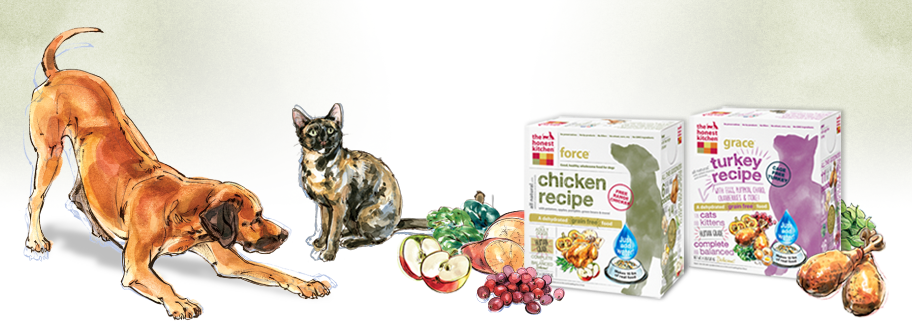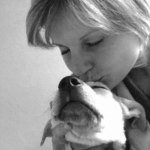
Studies have found that the pet with cancer has a metabolism much like a type two diabetic with insulin resistance. Cancer is fed by simple sugars, but cannot use fats, and uses protein very inefficiently. Thus the best diet for a patient with cancer is one that does not encourage the cancer growth by feeding it the nutrients the cancer thrives on.
Naturally, the diet must be palatable as well as balanced and complete for the special needs if your pet has cancer or other chronic debilitating diseases. The diet must supply sufficient calories for your pets needs, without putting excess pounds, nor causing it to become too thin.
The “cancer diet” nutrient profile very closely matches the diet used commonly with Type 2 Diabetics: Rich in highly-bioavailable protein and long-chain polyunsaturated fatty acids; Absent in simple sugars; Moderately-low in complex carbohydrates. Carbs are of the low glycemic index variety and high in fiber, both soluble and insoluble, from fresh vegetables and flax seed meal.
Finding a commercial diet that fits all of these criteria can be difficult, which is why I suggest that folks consider home preparation. I will cover that material in the blog that follows this one. It may be difficult to find such a diet, but not impossible, if one is willing to make some compromises.
Kibble (Dry) Diets
[/mk_fancy_title]
All kibble needs to be baked, heated and placed under pressure in order to form those little crunchy nuggets that our pets love so much. Most all kibble needs to be made from 50% of a material that holds the nugget together, such as grains, carbohydrates, potatoes, sweet potatoes.
This makes it difficult to find a commercial dry kibbled dog food that also provides a low carbohydrate environment. Carbohydrates themselves are known to contribute to inflammation when ingested in too high an amount. I also have concerns that dry foods are preserved with materials that have the possibility of being endocrine disruptors, and which, like ethoxyquin can also contribute early renal disease. This is also the case with BPA that is used to line cat and dog food canned foods. A number of studies have definitively linked hyperthyroidism in cats to the BPA in their food cans.
So when you are shopping for a dry pet food, read the label and try to find the highest percentage of protein as you can. There are a few diets out there that, according to label values, provide more than 50% protein on a dry matter basis. This is as good as it gets for dry food and cancer patients. It may be that this is your only choice due to available time, available funds, available skills, or your pet’s particularly fussy palate that refuses even your gourmet cooking!
The most important thing regarding diets for cancer patients is: “Keep them eating. Feed them what they will eat.”
I’ve seen some people who would keep feeding their pet the same home-made raw food every day, loaded with tons of supplements, and then would complain that they had appetite problems because they weren’t eating that supplement-laden “witches brew”. Don’t stand on your principles, feed them junk food if that is all they will eat. Keeping the pet with cancer eating is the mantra of Quality of Life management.
Canned Foods
[/mk_fancy_title]
Canned diets do not need to have carbohydrates in them to facilitate their holding together as kibbles need to, so it may be possible to go over the labels of every canned pet diet you can find to read the protein content of the can, to see if it has high protein.
Other than issues with the cost of canned foods, the fire retardants such as BPA used to line canned foods, and the disruptive effects of the high heat and pressures used in the canning process, canned food can provide a convenient source of a nutrient profile that helps to support the pet with cancer.
Dehydrated Food
[/mk_fancy_title]
Relatively new in pet food stores are dehydrated pet foods. That is, just add hot water, and let sit, then the vacuum dried vegetables, and meat, and sweet potatoes will reconstitute, and then your pet eats that. Kind of like camping food for us. Its convenient, can be found in organic and a variety of different ingredient lists for the pet with a sensitive digestion.
The Honest Kitchen™, which is the originator of this style of pet food diet, located in San Diego, makes a diet called “Preference” that I use in my own home diet preparations for my own goofy pets who are terribly spoiled, and they know it!
What I like about the “Preference”, is that it does not contain any meat. So I use it as a green food, rich in plant-based antioxidants, fiber, vitamins, phytonutrients, then I add the meat to this mix, add hot water, and we are good to go.
Generally for my own pets who do not have cancer, I use about 30% of the amount of “Preference” material suggested be used as a stand alone diet. I mix that 1/4 cup with my starch source, which these days with chronic diarrhea in my new puppy, I am using wet-cooked white rice as my starch; I use either a raw ground turkey roll for my protein source, or have been using a cooked turkey breast, which controls the diarrhea better. Fish oil, probiotics, antioxidants, medical mushrooms, yeast-based beta glucans, flax seed meal, calcium supplement, powdered multivitamin.
RAW or COOKED Freezer/Refrigerator Case Meals
[/mk_fancy_title]
The last 10 years has seen a revolution in the pet food marketplace with the introduction of frozen raw meat diets. They have become extremely popular, despite their high price tag. Most users will recount their personal stories of how well the raw diet has addressed a variety of health issues that nothing else was able to touch. Issues like poor-doing skin and hair coat, chronically soft stools, halitosis, goopy, smelly ears, even cancer.
We recommend against the use of raw food during immunosuppressive therapies, and certainly if in your household you have some humans who are undergoing chemotherapy or radiation therapy, then you need to be careful not to expose them to the raw food so they don’t contract the food-borne pathogens that might be in the food. Also, with infants whose immune systems are also underdeveloped, make sure they stay away from the raw food.
Even with admonitions against the use of raw diets, many folks still provide them, even when their pets are undergoing immunosupressive cancer therapies. Amazingly, most people report that their pets did fine without any problems with raw food diets in spite of the immune-suppressive nature of their cancer therapies.





